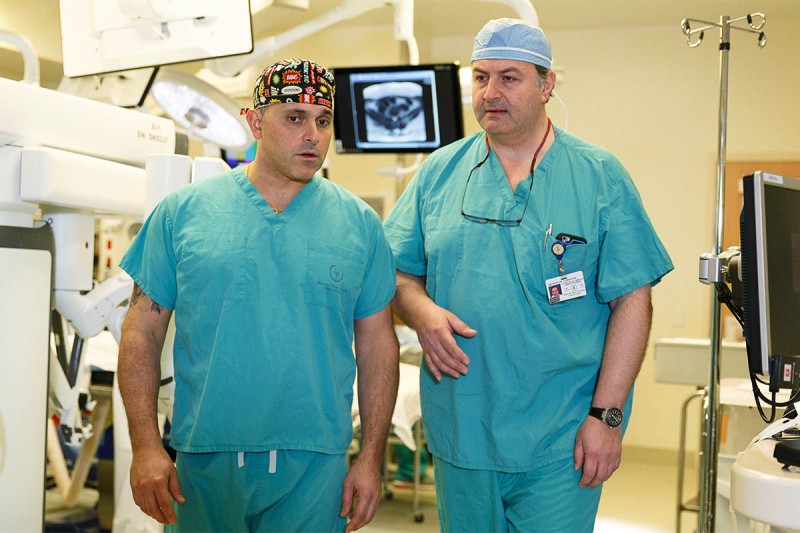
Oncologic outcomes are similar with the use of a sentinel lymph node (SLN) algorithm compared to performing a full pelvic and paraaortic lymph node dissection (LND) in node-negative patients with deeply invasive endometroid endometrial carcinoma (EEC), according to our recent research, the first to compare these two assessment methods in this patient population.
The study compared outcomes for a total of 176 node-negative patients with deeply invasive EEC: 82 patients were treated with the SLN algorithm at Memorial Sloan Kettering Cancer Center from 2005 to 2013 and 94 patients were treated with a full LND at the Mayo Clinic in Rochester, Minnesota, from 2004 to 2008. (1)
Overall, the study found no association between the assessment method and progression-free survival or overall survival. The findings suggest that the more conservative approach using the SLN algorithm may help more patients minimize the morbidity of lymphedema and enjoy a higher quality of life without compromising survival rates.
Sentinel Lymph Node Assessment Method
The extent of lymph node evaluation in the surgical management of endometrial cancer continues to be an area of debate. Approaches range from no lymphadenectomy based on tumor characteristics observed in frozen section to full pelvic and paraaortic LND. Lymph node metastases occur in approximately 20 percent of cases of endometrial tumors that are clinically confined to the uterus but demonstrate 50 percent or more myometrial invasion. As a result, lymph node assessment is more often performed in these patients. (2), (3)
Comprehensive lymphadenectomy in low-risk endometrial cancer is associated with intraoperative complications, including increased operating time, nerve and vessel injury, higher blood loss, and postoperative morbidity. (4) The rate of long-term lymphedema directly due to lymphadenectomy in these patients has been reported at 23 percent. Once present, the symptoms and effects of lymphedema — which include pain, skin breakdown, impaired mobility, difficulty with self-care, psychosocial morbidity, and impaired quality of life — can only be managed, not reversed. (5)
The SLN approach has been gaining in popularity as a potentially less morbid method for lymph node assessment in apparent early-stage endometrial carcinoma. (6), (7), (8) It was added to the National Comprehensive Cancer Network Clinical Practice Guidelines in 2018. (9) In endometrial tumors with limited endometrial invasion, the SLN algorithm demonstrated a higher detection rate in stage IIIC1 disease and a similar detection rate in stage IIIC2 disease compared to selective nodal assessment based on tumor characteristics — with no difference in oncologic outcomes. (4)
However, in the setting of deeply invasive EEC, there are only a few reports that have evaluated the safety and efficacy of the SLN algorithm. (3), (10) As a result, there is no agreement on the optimal method for assessing lymph nodes in this patient population. Full pelvic LND has been advocated, but data show that the rate of lymphedema increases when ten or more lymph nodes are removed. (1)
Comparing the SLN Algorithm and Full LND Approach
For the present study, we identified 82 MSK patients with newly diagnosed uterine-confined EEC of any grade — excluding stage IV — and 50 percent or more myometrial invasion who were treated with the SLN algorithm between 2005 and 2013. Our collaborating colleagues at the Mayo Clinic identified 95 of their patients with the same clinical characteristics who were treated with LND between 2004 and 2008. Thus, the surgical algorithm for endometrial carcinoma staging differed only by the method of lymph node assessment. Both cohorts of patients underwent hysterectomy, bilateral salpingo-oophorectomy, and peritoneal cytology. (1)
At MSK, surgical evaluation included the SLN algorithm, as per our institutional protocol. (5) The approach involved performing lymphatic mapping by injecting dye into deep and superficial cervical stroma at 3 o’clock and 9 o’clock prior to staging. The peritoneal cavity was inspected for evidence of metastases. The retroperitoneum was also examined, and any suspicious or enlarged nonsentinel lymph nodes were removed along with identified sentinel nodes. Full LND was performed on any nonmapping hemipelvis. (1)
Excised SLNs were evaluated with the MSK Pathologic Processing Protocol, known as “ultrastaging,” (11) which includes standard lymph node assessment with longitudinal sectioning and staining to assess the presence of metastatic tumor cells. If tumor cells were detected, the node was considered positive. If no tumor cells were identified, the SLN was serially sectioned and stained to assess for the presence of low-volume metastases. Macrometastasis (any nodal metastasis 2 millimeters [mm] or larger), micrometastasis (any nodal metastasis N 0.2 mm but b2 mm), and isolated tumor cells (defined as metastasis 0.2 mm or less) were considered node positive. (1)
For the cohort at the Mayo Clinic who received full LND, the surgical algorithm included intraoperative assessment of tumor characteristics followed by full pelvic and paraaortic LND to the renal veins. Any patient with grade 3 endometrioid histology on evaluation of a frozen section or any nonendometrioid histology, 50 percent or higher myometrial invasion, or tumor size greater than two cm underwent lymphadenectomy. (1)
Overall, the results of the retrospective analysis found no statistically significant association between the method of nodal assessment and cancer recurrence, with an adjusted hazard ratio for full LND versus the SLN algorithm of 0.87 (95 percent confidence interval [CI]: 0.40, 1.89) for progression-free survival and 0.77 (95 percent CI: 0.30, 1.96) for nonvaginal progression-free survival. (1)
Advancing Endometrial Cancer Care
At MSK, we are committed to improving oncologic outcomes while minimizing the burden of treatment. Our endometrial cancer team of surgeons, medical oncologists, radiation therapists, radiologists, pathologists, sexual health experts, and social workers collaborate to determine the optimal treatment approach for individual patients.
We continue to advance endometrial cancer care with leading-edge surgical and diagnostic techniques. Fertility preservation options are available for women with uterine cancer who would like to consider becoming pregnant in the future. Through innovative clinical trials, we are investigating new agents and combination chemotherapy regimens to find new ways to treat endometrial cancer.

